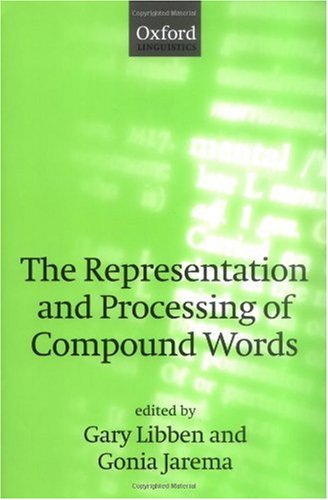

Most ebook files are in PDF format, so you can easily read them using various software such as Foxit Reader or directly on the Google Chrome browser.
Some ebook files are released by publishers in other formats such as .awz, .mobi, .epub, .fb2, etc. You may need to install specific software to read these formats on mobile/PC, such as Calibre.
Please read the tutorial at this link: https://ebookbell.com/faq
We offer FREE conversion to the popular formats you request; however, this may take some time. Therefore, right after payment, please email us, and we will try to provide the service as quickly as possible.
For some exceptional file formats or broken links (if any), please refrain from opening any disputes. Instead, email us first, and we will try to assist within a maximum of 6 hours.
EbookBell Team

4.0
76 reviews
ISBN 10: 0191536482
ISBN 13: 9780191536489
Author: Gary Libben, Gonia Jarema
This book presents new work on the psycholinguistics and neurolinguistics of compound words. It shows the insights this work offers on natural language processing and the relation between language, mind, and memory. Compounding is an easy and effective way to create and transfer meanings. By building new lexical items based on the meanings of existing items, compounds can usually be understood on first presentation, though - as, say, breadboard, cardboard, cupboard, and sandwich-board show - the rules governing the relations between the components' meanings are not always straightforward. Compound words are segmentable into their constituent morphemes in much the same way as sentences can be divided into their constituent words: children and adults would not otherwise find them interpretable. But compound sequences may also be independent lexical items that can be retrieved for production as single entities and whose idiosyncratic meanings are stored in the mind. Compound words reflect the properties both of linguistic representation in the mind and of grammatical processing. They thus offer opportunities for investigating key aspects of the mental operations involved in language: for example, the interplay between storage and computation; the manner in which morphological and semantic factors impact on the nature of storage; and the way the mind's computational processes serve on-line language comprehension and production. This book explores the nature of these opportunities, assesses what is known, and considers what may yet be discovered and how.
1 Why Study Compound Processing? An overview of the issues
2 Compound Types
3 Compound Representation and Processing: A cross-language perspective
4 The Neuropsychology of Compound Words
5 Preschool Children’s Acquisition of Compounds
6 Doghouse/Chien-maison/Niche: Approaches to the understanding of compound processing in bilinguals
7 Conceptual Combination: Implications for the mental lexicon
8 Processing Chinese Compounds: A survey of the literature
the representation and processing of compound words
nouns (names compound nouns) practice 1
nouns (names compound nouns) practice 1 answers
the definition of a compound noun
Tags: Gary Libben, Gonia Jarema, Representation, Processing